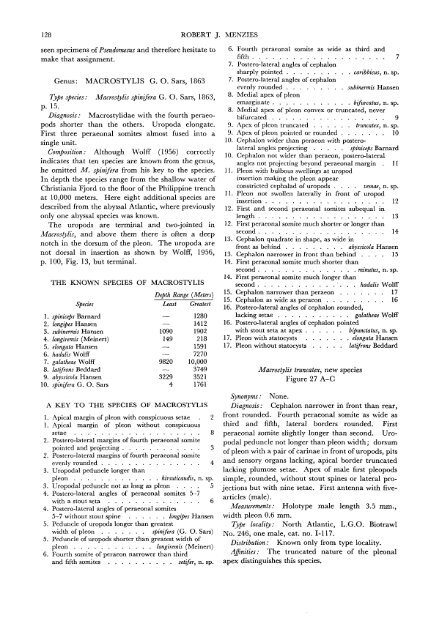The Isopods of Abyssal Depths in the Atlantic Ocean
The Isopods of Abyssal Depths in the Atlantic Ocean
The Isopods of Abyssal Depths in the Atlantic Ocean
You also want an ePaper? Increase the reach of your titles
YUMPU automatically turns print PDFs into web optimized ePapers that Google loves.
128 ROBERT J. MENZIES<br />
seen specimens <strong>of</strong> Pseudomesus and <strong>the</strong>refore hesitate to<br />
make that assignment.<br />
Genus: MACROSTYLIS G. O. Sars, 1863<br />
Type species: Macrostylis sp<strong>in</strong>ifera G. O. Sars, 1863,<br />
p. 15.<br />
Diagnosis: Macrostylidae with <strong>the</strong> fourth peraeopods<br />
shorter than <strong>the</strong> o<strong>the</strong>rs. Uropoda elongate.<br />
First three peraeonal somites almost fused <strong>in</strong>to a<br />
s<strong>in</strong>gle unit.<br />
Composition: Although Wolff (1956) correctly<br />
<strong>in</strong>dicates that ten species are known from <strong>the</strong> genus,<br />
he omitted M. sp<strong>in</strong>ifera from his key to <strong>the</strong> species.<br />
In depth <strong>the</strong> species range from <strong>the</strong> shallow water <strong>of</strong><br />
Christiania Fjord to <strong>the</strong> floor <strong>of</strong> <strong>the</strong> Philipp<strong>in</strong>e trench<br />
at 10,000 meters. Here eight additional species are<br />
described from <strong>the</strong> abyssal <strong>Atlantic</strong>, where previously<br />
only one abyssal species was known.<br />
<strong>The</strong> uropods are term<strong>in</strong>al and two-jo<strong>in</strong>ted <strong>in</strong><br />
Macrostylis, and above <strong>the</strong>m <strong>the</strong>re is <strong>of</strong>ten a deep<br />
notch <strong>in</strong> <strong>the</strong> dorsum <strong>of</strong> <strong>the</strong> pleon. <strong>The</strong> uropoda are<br />
not dorsal <strong>in</strong> <strong>in</strong>sertion as shown by Wolff, 1956,<br />
p. 100, Fig. 13, but term<strong>in</strong>al.<br />
THE KNOWN SPECIES OF MACROSTYLIS<br />
Species<br />
1. sp<strong>in</strong>iceps Barnard<br />
2. longipes Hansen<br />
3. sub<strong>in</strong>ermis Hansen<br />
4. longiremis (Me<strong>in</strong>ert)<br />
5. elongata Hansen<br />
6. hadalis Wolff<br />
7. gala<strong>the</strong>ae Wolff<br />
8. latifrons Beddard<br />
9. abyssicola Hansen<br />
0. sp<strong>in</strong>ifera G. O. Sars<br />
Depth Range {Meters)<br />
Least Greatest<br />
—<br />
—<br />
1090<br />
149<br />
—<br />
—<br />
9820<br />
—<br />
3229<br />
4<br />
1280<br />
1412<br />
1902<br />
218<br />
1591<br />
7270<br />
10,000<br />
3749<br />
3521<br />
1761<br />
A KEY TO THE SPECIES OF MACROSTYLIS<br />
1. Apical marg<strong>in</strong> <strong>of</strong> pleon with conspicuous setae . 2<br />
1. Apical marg<strong>in</strong> <strong>of</strong> pleon without conspicuous<br />
setae 8<br />
2. Postero-lateral marg<strong>in</strong>s <strong>of</strong> fourth peraeonal somite<br />
po<strong>in</strong>ted and project<strong>in</strong>g 3<br />
2. Postero-lateral marg<strong>in</strong>s <strong>of</strong> fourth peraeonal somite<br />
evenly rounded 4<br />
3. Uropodal peduncle longer than<br />
pleon hirsuticaudis, n. sp.<br />
3. Uropodal peduncle not as long as pleon . . . . 5<br />
4. Postero-lateral angles <strong>of</strong> peraeonal somites 5-7<br />
with a stout seta 6<br />
4. Postero-lateral angles <strong>of</strong> peraeonal somites<br />
5-7 without stout sp<strong>in</strong>e longipes Hansen<br />
5. Peduncle <strong>of</strong> uropods longer than greatest<br />
width <strong>of</strong> pleon sp<strong>in</strong>ifera (G. O. Sars)<br />
5. Peduncle <strong>of</strong> uropods shorter than greatest width <strong>of</strong><br />
pleon longiremis (Me<strong>in</strong>ert)<br />
6. Fourth somite <strong>of</strong> peraeon narrower than third<br />
and fifth somites setifer, n. sp.<br />
6. Fourth peraeonal somite as wide as third and<br />
fifth<br />
7. Postero-lateral angles <strong>of</strong> cephalon<br />
7<br />
sharply po<strong>in</strong>ted<br />
7. Postero-lateral angles <strong>of</strong> cephalon<br />
caribbkus, n. sp.<br />
evenly rounded<br />
8. Medial apex <strong>of</strong> pleon<br />
sub<strong>in</strong>ermis Hansen<br />
emarg<strong>in</strong>ate bifurcatus, n. sp.<br />
8. Medial apex <strong>of</strong> pleon convex or truncated, never<br />
bifurcated 9<br />
9. Apex <strong>of</strong> pleon truncated truncatex, n. sp.<br />
9. Apex <strong>of</strong> pleon po<strong>in</strong>ted or rounded 10<br />
10. Cephalon wider than peraeon with posterolateral<br />
angles project<strong>in</strong>g sp<strong>in</strong>iceps Barnard<br />
10. Cephalon not wider than peraeon, postero-lateral<br />
angles not project<strong>in</strong>g beyond peraeonal marg<strong>in</strong> . 11<br />
11 Pleon with bulbous swell<strong>in</strong>gs at uropod<br />
<strong>in</strong>sertion mak<strong>in</strong>g <strong>the</strong> pleon appear<br />
constricted cephalad <strong>of</strong> uropods . . . . vemae, n. sp.<br />
11 Pleon not swollen laterally <strong>in</strong> front <strong>of</strong> uropod<br />
<strong>in</strong>sertion 12<br />
12 First and second peraeonal somites subequal <strong>in</strong><br />
length 13<br />
12 First peraeonal somite much shorter or longer than<br />
second 14<br />
13. Cephalon quadrate <strong>in</strong> shape, as wide <strong>in</strong><br />
13<br />
14<br />
14.<br />
15.<br />
front as beh<strong>in</strong>d abyssicola Hansen<br />
Cephalon narrower <strong>in</strong> front than beh<strong>in</strong>d . . . . 15<br />
First peraeonal somite much shorter than<br />
second m<strong>in</strong>utus, n. sp.<br />
First peraeonal somite much longer than<br />
second . hadalis Wolff<br />
Cephalon narrower than peraeon 17<br />
15. Cephalon as wide as peraeon 16<br />
16. Postero-lateral angles <strong>of</strong> cephalon rounded,<br />
lack<strong>in</strong>g setae gala<strong>the</strong>ae Wolff<br />
16. Postero-lateral angles <strong>of</strong> cephalon po<strong>in</strong>ted<br />
with stout seta at apex bipunctatus, n. sp.<br />
17. Pleon with statocysts elongata Hansen<br />
17. Pleon without statocysts latifrons Beddard<br />
Macrostylis truncatex, new species<br />
Figure 27 A-G<br />
Synonyms: None.<br />
Diagnosis: Cephalon narrower <strong>in</strong> front than rear,<br />
front rounded. Fourth peraeonal somite as wide as<br />
third and fifth, lateral borders rounded. First<br />
peraeonal somite slightly longer than second. Uropodal<br />
peduncle not longer than pleon width; dorsum<br />
<strong>of</strong> pleon with a pair <strong>of</strong> car<strong>in</strong>ae <strong>in</strong> front <strong>of</strong> uropods, pits<br />
and sensory organs lack<strong>in</strong>g, apical border truncated<br />
lack<strong>in</strong>g plumose setae. Apex <strong>of</strong> male first pleopods<br />
simple, rounded, without stout sp<strong>in</strong>es or lateral projections<br />
but with n<strong>in</strong>e setae. First antenna with fivearticles<br />
(male).<br />
Measurements: Holotype male length 3.5 mm.,<br />
width pleon 0.6 mm.<br />
Type locality: North <strong>Atlantic</strong>, L.G.O. Biotrawl<br />
No. 246, one male, cat. no. 1-117.<br />
Distribution: Known only from type locality.<br />
Aff<strong>in</strong>ities: <strong>The</strong> truncated nature <strong>of</strong> <strong>the</strong> pleonal<br />
apex dist<strong>in</strong>guishes this species.

















